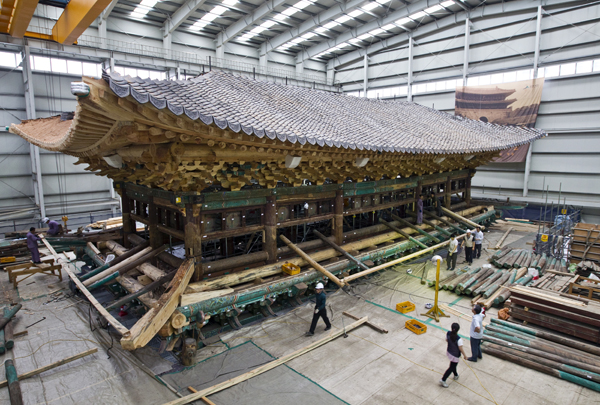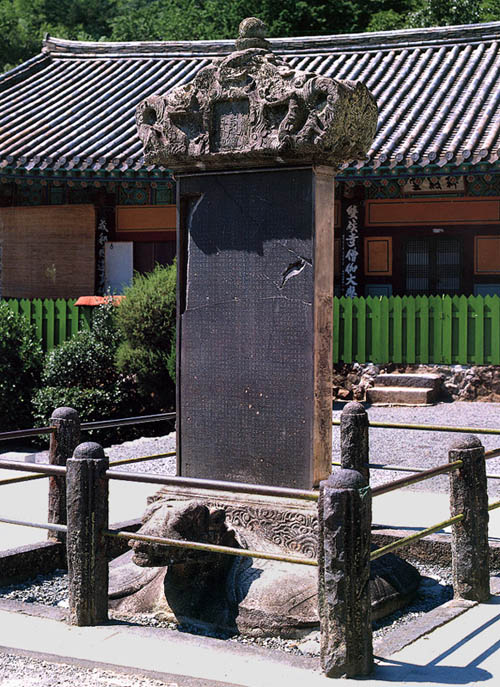Deadlines blamed in botched repairs

The obsession to meet the restoration deadline is one of the reasons behind the current damage to Sungnyemun, sources say. [JoongAng Ilbo]
One of the main culprits behind the damages to Sungnyemun, Korea’s recently restored state treasure, is slapdash construction amid an extreme focus on meeting the deadline the government pledged to complete the restoration by, an insider told the JoongAng Ilbo.
“Officials of the Cultural Heritage Administration, as well as other government officials, often told us that we should meet the deadline [which was initially set for December 2012],” one official who oversaw the restoration from February 2010 to May - which was when the restoration was completed - said in a recent interview. “We would tell them that we need more time, but they wouldn’t listen.”
The 600-year-old wooden gate that served as the main gateway to the capital, which was surrounded by an 18-kilometer (11.7-mile) fortress during the Joseon Dynasty (1392-1910), was burned down in an arson in February 2008. After an archaeological excavation, the restoration - one of the most high profile and expensive restorations of a cultural property in Korea’s history - kicked off in 2010.
The source went on to say that “the fact that the government would set a deadline on the restoration of National Treasure No. 1 is a problem.” Although numbers on Korea’s state-designated cultural properties don’t mean much, as they are given for administrative purposes, Sungnyemun, otherwise known as Namdaemun (Southern Main Gate), is still one of the most beloved treasures in the country.

The Stone Pagoda of Mireuk Temple site (Korea’s National Treasure No. 11) in Iksan, North Jeolla
A day after the arson
The source’s allegation is backed by what we found on the transcripts of the minutes recorded at meetings with an advisory panel to the restoration process.
At the 20th meeting, held on July 4, 2012, there was a debate on whether or not the restoration should adopt traditional methods “in a situation where the deadline is not so far away,” which indicates that some were willing to make compromises in order to meet the deadline.
In fact, a day after the arson, the Cultural Heritage Administration (CHA) vowed to the public that it would restore the gate in three years.
“The restoration process is expected to take about three years and will likely cost around 20 billion won,” Lee Seong-won, a CHA official, told journalists on Feb. 11, 2008.
On May 20 of that year, the CHA announced a “Basic Plan for Sungnyemun Restoration,” which revised the period of the restoration process from the initial three years to four years and seven months - one year and seven months for archaeological excavation, research and design, and three years for the construction.
One artisan who took part in the restoration said “it was way too short to restore the gate in a 100 percent traditional way,” adding that “it was true that they were rushed to meet the deadline.”
How the deadline was set
One of the key political figures who was deeply involved in the Sungnyemun restoration was former president Lee Myung-bak.
He was one of the first to visit the site, at around 10:20 a.m. on Feb. 11, 2008. At the time he was the winner of the presidential race and was slated to be inaugurated two weeks later.
“We will restore Sungnyemun as soon as possible and console the Korean people,” he said with a somber face.
In fact, he had reason to be involved. It was in March 2006 - when Lee was the mayor of Seoul - that the gate, which was previously off limits to the public, was reopened for public viewing, thus allowing the arson to happen.
Critics say Lee was partially to blame: As a former construction company CEO, he is responsible for certain makeovers of city landmarks, including the restoration of Cheonggye Stream. Reactions to his projects are divided.
Observers say that given Lee’s reputation for speed and building things (one of his nicknames was “bulldozer”), it was natural that Lee would have liked to see the restoration completed during his tenure, which was five years.
“We were rushed because Sungnyemun had to be restored within the president’s tenure,” one source who worked on the restoration site said.
“We suggested waiting some time until the wood is settled and then moving on to painting them. But the suggestion was rejected as [the government] wanted to have a completion ceremony within the president’s tenure,” another source said.
However, as it turned out, the completion was set for December 2012, which was when the presidential election was held.
The minutes of the 21st meeting of the advisory panel, which took place on September 14, 2012, report that “[the participants] decided not to rush things as there is a presidential election and the administration will change anyway. They decided that the completion ceremony will take place after the election.”
Lee Hee-bong, a professor of architecture at Chung-Ang University said, “the restoration of cultural properties should be treated differently from other constructions .?.?. In particular, as the government decided to restore Sungnyemun in a 100 percent traditional way, they should’ve taken enough time in research.”
Taking a hint
Experts in the field of cultural properties say that the government can learn from the restoration of the Stone Pagoda of Mireuk Temple site (Korea’s National Treasure No. 11) in Iksan, North Jeolla, which officially kicked off last week.
Believed to have been created in the seventh century during the later years of Korea’s Baekje Kingdom (18 BC to 600 AD) the stone pagoda is the country’s oldest and largest.
Its ongoing restoration - which is a 19.5 billion won project set for completion in August 2016 - began 15 years after a regular safety inspection in 1998 found that the pagoda is in dangerous shape.
The dismantlement process and archaeological excavation alone took place for 10 years and research took another five years.
In 1999, the authorities decided to dismantle the pagoda. They studied ways to dismantle it for two years, and the process began in October 2001. It was completed 10 years later.
A lot of time was spent on taking off the concrete that the Japanese had put on the pagoda in 1915 during the colonial rule of the Korean Peninsula (1910-45).
After the dismantlement, scholars discussed whether or not they should restore the pagoda to nine stories, which many historians believe was its original height, or just to its present-day height of six stories. They decided to go with the latter proposal.
So, how was this possible?
Critics say it was mainly because it was not the CHA but the National Research Institute of Cultural Heritage that led the restoration. Although the institute is also a state-run organization, it is freer than the CHA from the government’s involvement, and the head of the organization at that time, Cho You-jeon, was determined to take enough time.
Cho reminisced that the people of the region blamed what appeared to be the slow process, eating up their tax money. “There were many criticisms, but I was determined that I would make this restoration a model one for our stone artifacts.”
“The know-how that the artisans accumulated in the process of taking off the concrete is the asset that will play a big role in the restoration of cultural properties in the future,” he said.
“[Authorities] should’ve also taken enough time with Sungnyemun - on ways to dismantle and restore it.”
BY SPECIAL REPORTING TEAM [hkim@joongang.co.kr]










with the Korea JoongAng Daily
To write comments, please log in to one of the accounts.
Standards Board Policy (0/250자)